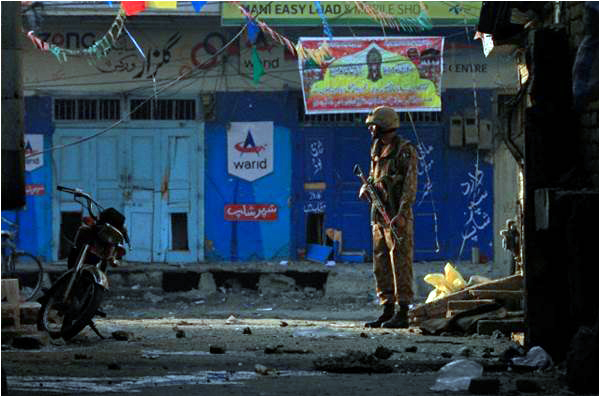Recent events and statements by the civilian leadership indicate that there is a move towards undertaking a military operation in North Waziristan Agency (NWA). This has been a much delayed option that haunts the state of Pakistan especially the power military which has lost thousands of personnel, officials and five generals in the past few years. If one adds the civilian casualties and the climate of fear that grips Pakistan. Earlier, media reports suggested that in a briefing the army was not too optimistic about the success of an operation. The Chairman of Pakistan Tehreek e Insaf, whose simplistic position on war, terrorism and domestic anarchy has been informing the discourse, had quoted 40% chances of success in a media interaction.
Admittedly, with a large number of civilians residing in NWA, air strikes and ground operations can be lethal as the recent bombings in Mir Ali demonstrated. The armed forces were successful in hitting valuable targets but it came with a cost. This was a route that ought to have been adopted years ago but Pakistan’s strategic calculations prevented such clarity. In large measure, high tolerance for the existence of a mini-Emirate within Pakistan’s territory was perhaps a means to allow the functioning of Afghan Taliban factions in NWA. This was an opportune moment for the Pakistani militants to increase their strength, enter into alliances with sectarian groups countrywide and enhance their ‘soft power’ through media interactions, and gain the sympathies of political parties such as Imran Khan’s PTI. The results have been disastrous for the country. Pakistanis while condemning acts of terror against civilians are willing to give leeway to the militants terming acts as an expression of resistance to Pakistan’s partnership with the US.
The country therefore has been locked into a faux debate – talks or operation. The truth is that any counter-terrorism strategy would entail both as a means to restore the writ of the state. This false polarization has been benefitted the militant groups across the country and obfuscated the real issue at hand i.e. the sliding grip of the state over Pakistani territory. From DG Khan to Waziristan and from Karachi to Quetta the network has grown stronger and has played on the strategic ‘necessity’ of Pakistan to tolerate the existence of India-centric jihadi and Afghan Taliban groups. This has minimized the options for Pakistan. A full scale operation would mean that the state may end up isolating the Afghan Taliban and thus lose leverage in the future Afghan ‘game’.
More importantly, the sectarian outfits operational in Punjab, Karachi and Balochistan, have multiplied in number due to splintering and turned into ‘untouchable’ entities due to local factors and foreign funding lines would also come into a direct confrontation with the state. Is there readiness or a modicum of willingness to take them on? Sadly, the chances are way too remote. The Prime Minister and his family came under threat a few months ago when the convicted members of Lashkar e Jhangvi were about to be hanged. That decision was also postponed. It is an open secret that these groups are in league with those who may be targets of a military operation in the northwest of the country.
Surgical strikes therefore will only bring short term dividends and perhaps allow the state to alter the power and perception balance against the militants. But it is not going to tackle the menace until a few issues are debated and dealt with. First, what is the scope of Pakistan’s ambition in Afghanistan? Are we headed towards another bid to support the Taliban power in post-NATO Afghanistan? The consequences of such an eventuality will be devastating for Pakistan as their Pakistani counterparts would be strengthened and clamour for more territory and political space within Pakistan. The two branches may have different goals but their tactics and strategy are the same. The time has come for the civilians to sit down with the military strategists and thrash this before they decide on the future course. Indeed a shift in the Taliban policy would require rescaling the ‘Indian threat’ in Afghanistan and rationalizing the threat perception that is chanted again and again in policy quarters. India can never have the same strategic leverage as Pakistan does. With a US-Iran thaw Pakistan could find itself far more isolated than it imagines itself to be.
Secondly, the excessive paranoia about US presence in the region needs to give way to a more realistic assessment of the future scenarios. It is a truism that no country in the world would like Pakistan to disintegrate or even suffer long periods of instability and mayhem. A nuclear Pakistan can only flourish with domestic stability. Thirdly, the Baloch insurgency, another flashpoint, predicates on how we can renegotiate our regional relationships with India, Afghanistan and Iran. The political solution that Nawaz Sharif has been talking about can help the military in pulling back a little from the scene and let politics of compromise and bargain find a way out.
The Prime Minister has now formed an ill-fated four-member committee to initiate dialogue with the Taliban, but without a willingness to review its strategic blunders of the past, the future course for Pakistani state would remain fraught with pitfalls. A military operation therefore must be a part of a broader strategy that aims to reset regional ties; uses force and dialogue judiciously; and changes the narratives at home. For the latter to happen, Sharif’s team would have to give up the temptation of competing with apologists of the militants and act like a responsible government that places national interest over populist antics.



